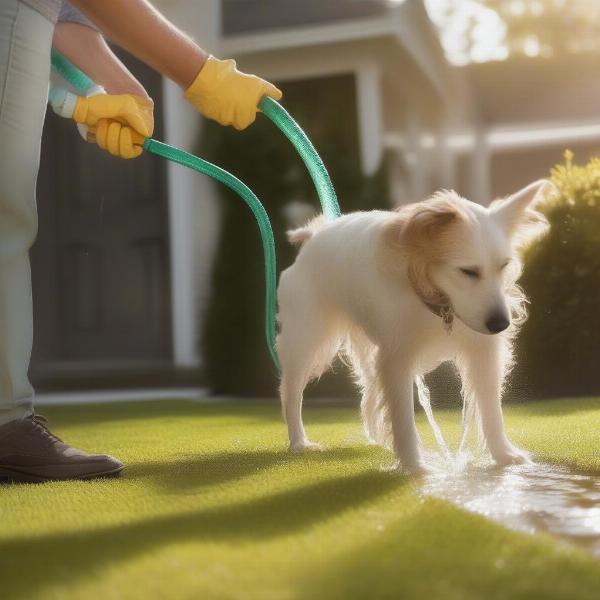Dealing with unsightly dog pee marks on your lawn is a common frustration for dog owners. These yellow or brown patches can detract from the beauty of your yard and leave you wondering what you can do to prevent or repair them. This guide will dive into the science behind why dog urine causes these spots and provide practical, actionable solutions to reclaim a lush, green lawn.
Why Does Dog Pee Kill Grass?
Dog urine contains nitrogen, which in concentrated amounts can act as a fertilizer burn, similar to over-fertilizing your lawn. The high concentration of nitrogen in a single spot causes the grass in that area to dehydrate and die, resulting in the tell-tale yellow patches. The effect is intensified by the salts and other compounds also present in urine.
Preventing Dog Pee Marks: Proactive Strategies
Preventing dog pee spots is often easier than trying to repair the damage after it’s done. Here are some proactive measures to consider:
- Hydration is Key: Ensure your dog has access to plenty of fresh water throughout the day. Diluted urine is less likely to damage your grass. Encourage drinking by adding a little low-sodium chicken broth or flavoring to their water.
- Designated Potty Area: Train your dog to urinate in a designated area of your yard, preferably one that’s less visible or planted with hardier ground cover. Mulch, gravel, or specific dog-friendly grasses are good choices.
- Dietary Adjustments: Some dog foods contain high levels of certain minerals that can contribute to lawn burn. Consult your veterinarian about switching to a food with lower nitrogen content or one specifically formulated to minimize the impact on your lawn.
Repairing Existing Damage: Bringing Your Lawn Back to Life
If your lawn already bears the scars of dog urine, don’t despair! Several effective remedies can help revitalize those damaged areas:
- Flush the Area: Immediately after your dog urinates, flush the spot thoroughly with water. This dilutes the nitrogen and helps prevent the grass from burning.
- Neutralize the Soil: Applying a neutralizing agent like gypsum to the affected area can help balance the pH of the soil and encourage grass regrowth. Follow product instructions carefully for best results.
 Watering a dog pee spot on the lawn to dilute urine
Watering a dog pee spot on the lawn to dilute urine
- Reseeding: For severe damage, you may need to reseed the affected areas. Choose a grass seed that is tolerant to dog urine or consider using a more resilient ground cover.
Choosing Dog-Friendly Grasses
Certain grass varieties are more tolerant to dog urine than others. If you’re starting a new lawn or planning to renovate, consider these options:
- Fescue: Known for its hardiness and tolerance to various conditions, including dog urine.
- Ryegrass: A fast-growing and durable grass that can withstand moderate urine exposure.
- Kentucky Bluegrass: While not as tolerant as fescue or ryegrass, it recovers relatively quickly from damage.
Conclusion
Dealing with dog pee marks on your lawn doesn’t have to be a constant battle. By understanding the science behind the problem and implementing preventative measures and repair strategies, you can maintain a healthy and beautiful lawn while providing a comfortable environment for your furry friend. Remember that consistent care and attention are key to achieving lasting results.
FAQ
- Why are some dog pee spots dark green instead of yellow? Small amounts of nitrogen can act as fertilizer, leading to localized, rapid growth and a darker green appearance.
- Will dog urine hurt my dog? No, dog urine itself is not harmful to dogs unless they have a pre-existing medical condition.
- Are female dog pee spots worse than male dog pee spots? Female dogs typically squat and deposit a larger amount of urine in a concentrated area, leading to more pronounced damage.
- Can I train my dog to pee in a specific spot? Yes, with consistent training and positive reinforcement, you can train your dog to use a designated potty area.
- What if none of these solutions work? Consult a lawn care professional or a veterinarian for specialized advice.
Introducing ILM Dog
ILM Dog is your one-stop resource for expert advice on all aspects of dog care, from breed selection and puppy care to senior dog health and training. We provide practical and reliable information to empower dog owners worldwide. Whether you’re a seasoned dog parent or just starting your journey, ILM Dog offers a wealth of knowledge to help you provide the best possible care for your canine companion. For personalized guidance and expert tips, contact us today! Email: [email protected], Phone: +44 20-3965-8624. Visit us online at https://ilmdog.com for more valuable resources on dog health, nutrition, training, and more!